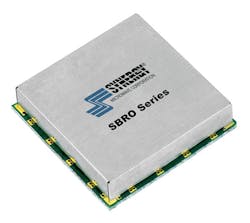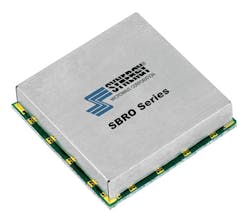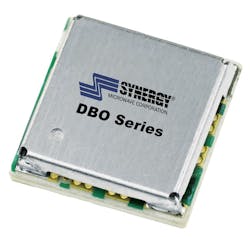This file type includes high resolution graphics and schematics when applicable.
Tunable voltage-controlled oscillators (VCOs) are essential components in microwave transceivers. One challenge in designing receivers, transmitters, and transceivers that must serve multiple wireless/frequency standards involves finding the right combination of VCOs that can cover multiple frequency bands, while also meeting space and power-consumption requirements for the system.
Fortunately, the design team at Synergy Microwave Corp. has developed multiple-band tunable oscillators using a switched-resonator approach, keeping package sizes small while minimizing such parameters as phase noise and power consumption. A number of standard models have been developed—including a triple-band unit covering 2000 to 2400 MHz, 2400 to 2800 MHz, and 2800 to 3000 MHz—but custom combinations of frequency bands are available with minimal nonrecurring-engineering (NRE) investment.
Attempts at constructing multiple-band frequency sources have included combining different VCOs, although this approach can lead to large circuits with high power consumption to minimize phase noise. A more attractive solution is a single source with multiple-frequency-band coverage. This has been done through the use of switched capacitor (C) arrays and switched inductors (L) with RF/microwave oscillators.
However, traditional switched LC resonators often suffer degraded performance due to the parasitic effects of the switching transistor, resulting in delayed startup conditions and also poor phase noise performance. Inductive switching can also be achieved by means of electromagnetic (EM) coupling, where the equivalent inductance of a primary coil is changed by a tunable driving current in a secondary coil via magnetic coupling. This approach avoids the switching transistor and its parasitic effects, and can achieve wide tuning ranges, although with a boost in power consumption because of the driving current.
This switched-resonator approach provides a significant savings in physical size and power consumption compared to the use of separate switched VCOs, while still providing multiple-frequency band coverage for multimode wireless communications systems. Synergy offers both approaches in its DBO, SBRO, and Triple-Band VCO models (Fig. 1), which employ multiple-coupled planar resonators (MCPRs) to handle multiple tunable frequency bands. This multiple-resonator technology supports tunable frequency ranges from 300 MHz to 18 GHz in compact housings.
For example, one of the SBRO sources (Fig. 1), the triple-band model SBVFC, measures just 0.9 x 0.9 in. but covers frequency bands of 2000 to 2400 MHz, 2400 to 2800 MHz, and 2800 to 3000 MHz with typical phase noise of -105 dBc/Hz offset 10 kHz from the carrier. It uses tuning voltages from 0 to 24 VDC and switching control voltages of 0 and +5 VDC with less than 1 mA current consumed. SBRO sources are also available in dual-band models measuring just 0.55 x 0.55 in.
Several DBO dual-band VCO models (Fig. 2) have been developed and encased in an even smaller housing measuring just 0.3 x 0.3 in. Model DCO5364-5 provides frequency tuning from 526 to 636 MHz and 636 to 726 MHz with typical phase noise of -103 dBc/Hz offset 10 kHz from the carrier. Model DCO7585-5 combines tuning ranges of 750 to 800 MHz and 800 to 850 MHz with typical phase noise of -102 dBc/Hz offset 10 kHz from the carrier. Both dual-band sources operate with switching control voltages of 0 and +5 VDC (and less than 1 mA current consumed) and tuning voltage range of 0 to +15 VDC. Of course, these multiple-band oscillators are merely examples of possible frequency ranges; customers are invited to submit requirements in terms of frequency range, output power, and spectral purity for their particular applications.
Synergy Microwave Corp., 201 McLean Blvd., Paterson, NJ 07504; (973) 881-8800.
This file type includes high resolution graphics and schematics when applicable.
About the Author
Jack Browne
Technical Contributor
Jack Browne, Technical Contributor, has worked in technical publishing for over 30 years. He managed the content and production of three technical journals while at the American Institute of Physics, including Medical Physics and the Journal of Vacuum Science & Technology. He has been a Publisher and Editor for Penton Media, started the firm’s Wireless Symposium & Exhibition trade show in 1993, and currently serves as Technical Contributor for that company's Microwaves & RF magazine. Browne, who holds a BS in Mathematics from City College of New York and BA degrees in English and Philosophy from Fordham University, is a member of the IEEE.



